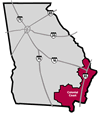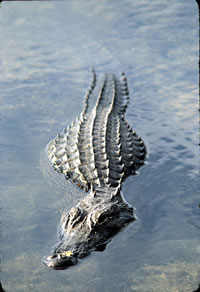
Wildlife Viewing Guide


|
Wildlife Viewing Guide |
 |
 Savannah
National Wildlife Refuge
Savannah
National Wildlife Refuge
 Description:
Savannah National Wildlife Refuge's 26,295 acres include freshwater marshes,
tidal rivers and creeks, bottomland hardwoods, and old rice fields of plantations
dating back to the mid- and late-1700s. Many of the dikes enclosing these pools
were originally built by slaves and itinerant Irishmen. All dikes are open to
foot travel during daylight hours unless otherwise posted and provide excellent
wildlife observation points. The Laurel Hill Wildlife Drive meanders along 4
miles of the earthen dikes through managed freshwater pools and hardwood hammocks.
About half the refuge is river bottomland composed mainly of cypress, gum, and
maple species. Although access to this area is primarily by boat, one dike,
the Tupelo Swamp Trail, is located adjacent to the northernmost impoundment
and affords visitors hiking opportunities within the bottomland habitat.
Description:
Savannah National Wildlife Refuge's 26,295 acres include freshwater marshes,
tidal rivers and creeks, bottomland hardwoods, and old rice fields of plantations
dating back to the mid- and late-1700s. Many of the dikes enclosing these pools
were originally built by slaves and itinerant Irishmen. All dikes are open to
foot travel during daylight hours unless otherwise posted and provide excellent
wildlife observation points. The Laurel Hill Wildlife Drive meanders along 4
miles of the earthen dikes through managed freshwater pools and hardwood hammocks.
About half the refuge is river bottomland composed mainly of cypress, gum, and
maple species. Although access to this area is primarily by boat, one dike,
the Tupelo Swamp Trail, is located adjacent to the northernmost impoundment
and affords visitors hiking opportunities within the bottomland habitat.
Viewing Information: During the winter months, thousands of ducks fill the impoundments, including the rarely-seen cinnamon teal, Eurasian wigeon, and fulvous whistling ducks. More frequently, birders have found tundra swans, greater white-fronted geese, and Canada geese. Other wintering birds include the peregrine falcon, northern harrier, short-eared owl, Virginia rail, common snipe, American woodcock, and a host of song and garden birds, including the American robin, hermit thrush, fox sparrow, and winter wren. Twenty-one species of warblers, including Swainson's, Cape May, worm-eating, blackpoll, black-throated blue, and magnolia, have been seen in spring and autumn migrations. The hardwood hammocks serve to concentrate the songbirds, much to the convenience of the birder. The summer months offer the refuge visitor sightings of purple gallinules and wood ducks, often in the company of their downy offspring, and flocks of white ibis and glossy ibis feeding together. American alligators are frequently seen on sunny winter days when these reptiles bask along the banks of the canals. The dikes may be temporarily closed to the public (November 1 - March 14) for management purposes. Closed areas are posted accordingly.
Directions: From Savannah, travel US Hwy. 17 north across the Talmadge Bridge. Turn left on SC Hwy. 170 south and look for the entrance to the wildlife drive on the left.
Management: U.S. Fish and Wildlife Service, Savannah Coastal Refuges, 912-652-4415
Closest Town: Savannah, GA
Site Notes: observation platforms, wildlife drive.
Additional Information: For refuge maps, bird checklist, or brochure, contact the Savannah Coastal Refuges office: Parkway Business Center, Suite 10, 1000 Business Center Drive, Savannah, GA 31405.
![]()
![]()
![]()
![]()
Read and add comments about this page